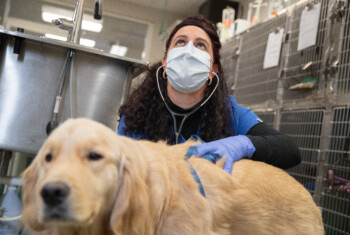Chronic bronchitis: Symptoms, diagnosis and treatment.
Chronic bronchitis is a disease in dogs that affects the smaller airways that branch out from the trachea (windpipe).
These branches, called bronchi and bronchioles, allow the transport of air into and out of the alveoli, the sites of oxygen exchange.
Typically, inflammation within the airways results in excessive secretions that plug the airways. The end result is an impaired ability to bring oxygen into the alveoli for delivery to the rest of the body.
Although the term “asthma” is occasionally used to describe this form of airway disease in dogs, this term is very misleading. Asthma in humans specifically refers to the reversible constriction of muscle within the walls of the bronchi. Chronic bronchitis (long duration, usually more than two to three months) is associated with inflammation and swelling of the walls of the bronchi resulting in narrowing of the airways and obstruction or blockage of airways by plugs of mucus or other secretions. The inflammation present in chronic bronchitis is not reversible.
As mentioned, bronchitis can be chronic or acute (short duration). Unlike chronic bronchitis, acute bronchitis is associated with reversible changes in the structure of the airways. Bronchitis may be caused by bacterial infections, hypersensitivity disorders (allergies), parasites (i.e., lungworms, heartworm) or chronic inhalation of airway irritants (second-hand smoke, dust, exhaust fumes, etc.). In chronic bronchitis, the underlying cause cannot be identified.
Symptoms.
The most common signs of chronic bronchitis include daily coughing, difficulty breathing or wheezing for two to three months or longer. Coughing is often more pronounced initially upon awakening and then reduces in frequency while awake and active. Episodes of coughing can mimic vomiting; you may think that your dog is vomiting when in fact your dog is having a coughing fit followed by retching.
Some severely affected dogs may have extreme exercise intolerance. These signs are not specific to bronchitis and can also be seen with many other diseases including heart failure, pneumonia, allergic lung disease and lung cancer.
Diagnosis.
To diagnose canine bronchitis, usually the first test is a chest radiograph (x-ray). The presence of radiographic changes to the airways combined with a clinical history of a middle- to older-aged dog with a cough for at least two to three months may be sufficient to establish a tentative clinical diagnosis of chronic bronchitis. However, bronchoalveolar lavage (BAL) may be recommended to exclude other airway diseases (lung parasites, allergic bronchitis).
This procedure allows for the collection of fluid and cells from your dog’s lungs. These samples are sent to a laboratory to determine what types of cellular changes are occurring in the lungs. If a bacterial or parasitic infection is present, the results will help assist in determining what therapy might be most effective.
Bronchoalveolar lavage does require anesthesia, so if the patient’s condition is critical, it may not be possible to do this procedure because of the increased risk of death.
Treatment.
Any underlying disease (i.e., bacterial or parasitic infection) must be diagnosed and treated. Changes may be needed in the dog’s environment. Dogs with chronic bronchitis often have sensitive airways, and the inhalation of irritating particles from certain environments may worsen their condition. It is strongly recommended that their exposure to smoke (cigarette or fireplace), dust (carpet fresheners, flea powder), and sprays (insecticides, hair spray, perfumes and cleaning products) be eliminated or minimized.
Two classes of medications are commonly prescribed: bronchodilators (theophylline, aminophylline, pentoxifylline, and terbutaline) and corticosteroids (prednisolone, prednisone, and methylprednisolone).
Bronchodilators (in theory) help to dilate or open the airways by relaxing the muscles around the airway walls. The overall effectiveness of these drugs alone is minimal in most dogs. Common side effects of bronchodilators in dogs can include vomiting, nausea, restlessness and lethargy. Pentoxifylline is unique in that it has anti-inflammatory effects and may be effective in some dogs with mild disease.
Corticosteroids are anti-inflammatory drugs that decrease the inflammation and swelling of the airway walls. These medications are most effective for the treatment of chronic bronchitis. Side effects of corticosteroids may include increased appetite, increased urination, increased thirst and anxiety (pacing, restlessness). Corticosteroid inhaler therapy is marginally effective, as our patients are not always cooperative, and delivery of the drug deep into the lungs is rarely achieved.
Prognosis.
The prognosis is variable with this disease. In most dogs, permanent damage to the airways has occurred and the disease cannot be cured. With proper medical management, clinical signs can usually be controlled and further damage to the bronchi can be stopped or slowed.
Periodic relapses of coughing are not unusual and require treatment. The cough is often not entirely eliminated, but reduced in patients with chronic bronchitis.
Some dogs with chronic bronchitis develop severe irreversible changes to the airways termed bronchiectasis. These dogs are highly susceptible to recurrent pneumonia. A sudden increase in cough in patients with bronchiectasis requires prompt evaluation and chest radiographs to determine whether pneumonia is present.
For more information on this subject, talk to the veterinarian treating your pet.


